Bronx Community | Research Report
VerifiedAdded on 2022/08/17
|25
|3150
|15
AI Summary
Contribute Materials
Your contribution can guide someone’s learning journey. Share your
documents today.

Running head: COMMUNITY HEALTH 1
Community Health
Name of Author
Institution of Affiliation
Date of Submission
Community Health
Name of Author
Institution of Affiliation
Date of Submission
Secure Best Marks with AI Grader
Need help grading? Try our AI Grader for instant feedback on your assignments.
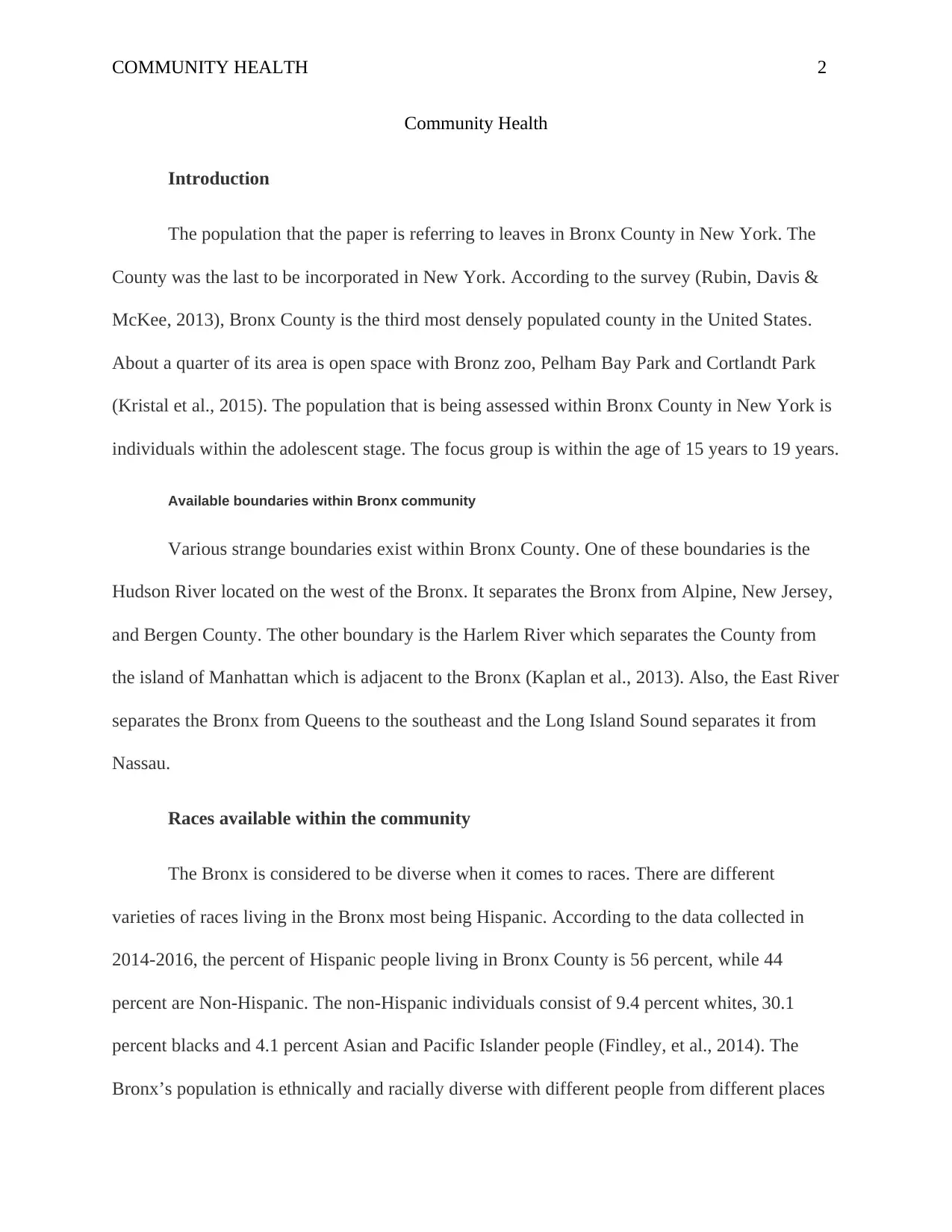
COMMUNITY HEALTH 2
Community Health
Introduction
The population that the paper is referring to leaves in Bronx County in New York. The
County was the last to be incorporated in New York. According to the survey (Rubin, Davis &
McKee, 2013), Bronx County is the third most densely populated county in the United States.
About a quarter of its area is open space with Bronz zoo, Pelham Bay Park and Cortlandt Park
(Kristal et al., 2015). The population that is being assessed within Bronx County in New York is
individuals within the adolescent stage. The focus group is within the age of 15 years to 19 years.
Available boundaries within Bronx community
Various strange boundaries exist within Bronx County. One of these boundaries is the
Hudson River located on the west of the Bronx. It separates the Bronx from Alpine, New Jersey,
and Bergen County. The other boundary is the Harlem River which separates the County from
the island of Manhattan which is adjacent to the Bronx (Kaplan et al., 2013). Also, the East River
separates the Bronx from Queens to the southeast and the Long Island Sound separates it from
Nassau.
Races available within the community
The Bronx is considered to be diverse when it comes to races. There are different
varieties of races living in the Bronx most being Hispanic. According to the data collected in
2014-2016, the percent of Hispanic people living in Bronx County is 56 percent, while 44
percent are Non-Hispanic. The non-Hispanic individuals consist of 9.4 percent whites, 30.1
percent blacks and 4.1 percent Asian and Pacific Islander people (Findley, et al., 2014). The
Bronx’s population is ethnically and racially diverse with different people from different places
Community Health
Introduction
The population that the paper is referring to leaves in Bronx County in New York. The
County was the last to be incorporated in New York. According to the survey (Rubin, Davis &
McKee, 2013), Bronx County is the third most densely populated county in the United States.
About a quarter of its area is open space with Bronz zoo, Pelham Bay Park and Cortlandt Park
(Kristal et al., 2015). The population that is being assessed within Bronx County in New York is
individuals within the adolescent stage. The focus group is within the age of 15 years to 19 years.
Available boundaries within Bronx community
Various strange boundaries exist within Bronx County. One of these boundaries is the
Hudson River located on the west of the Bronx. It separates the Bronx from Alpine, New Jersey,
and Bergen County. The other boundary is the Harlem River which separates the County from
the island of Manhattan which is adjacent to the Bronx (Kaplan et al., 2013). Also, the East River
separates the Bronx from Queens to the southeast and the Long Island Sound separates it from
Nassau.
Races available within the community
The Bronx is considered to be diverse when it comes to races. There are different
varieties of races living in the Bronx most being Hispanic. According to the data collected in
2014-2016, the percent of Hispanic people living in Bronx County is 56 percent, while 44
percent are Non-Hispanic. The non-Hispanic individuals consist of 9.4 percent whites, 30.1
percent blacks and 4.1 percent Asian and Pacific Islander people (Findley, et al., 2014). The
Bronx’s population is ethnically and racially diverse with different people from different places

COMMUNITY HEALTH 3
living together. In approximation, 37 percent of Bronx are Black American which is a much
larger percentage when compared to other counties in New York. The black Americans
population includes the US-born and immigrants from Africa and Caribbean countries. Over half
of the populations are identified as Hispanic who historically was from Puerto Rico. Currently,
there are more immigrants from Central America and the Dominican Republic. In
approximation, four percent of individuals living in the Bronx is Asian from different parts of
Pakistani and Bangladeshi (Patel, Rajpathak & Karasz, 2012).
According to the available data from (Checkoway et al., 2012), about 19 percent of
individuals living in the Bronx are not US citizens. It is estimated that about 468,927 people who
represent one-third of people living in the Bronx were born outside of the US (Ingram, 2014).
The high percentage of these people can be found on the western edges of Crotona
Tremont and in Fordham Park. Most of these residents speak less English. Access to services
such as health and education are limited in these places as most fear deportation. According to
(Fabricant, 2010), most of the individuals who are undocumented always avoid providing their
information regarding their citizenship and identity as this might make them be deported to their
home countries. Besides, most of these foreigners speak less English thus may experience
cultural barriers to health care access. Other residents complain about the quality of language
services being provided thus the avoidance of health care services (Ingram, 2014).
In estimation, about half of Bronx residents speak other languages other than English
(Smouha, 2012). About 46 percent are thought to speak Spanish, 3 percent African language and
about 1 percent speaks in French including Indo-European and Italian languages as shown in the
table below.
living together. In approximation, 37 percent of Bronx are Black American which is a much
larger percentage when compared to other counties in New York. The black Americans
population includes the US-born and immigrants from Africa and Caribbean countries. Over half
of the populations are identified as Hispanic who historically was from Puerto Rico. Currently,
there are more immigrants from Central America and the Dominican Republic. In
approximation, four percent of individuals living in the Bronx is Asian from different parts of
Pakistani and Bangladeshi (Patel, Rajpathak & Karasz, 2012).
According to the available data from (Checkoway et al., 2012), about 19 percent of
individuals living in the Bronx are not US citizens. It is estimated that about 468,927 people who
represent one-third of people living in the Bronx were born outside of the US (Ingram, 2014).
The high percentage of these people can be found on the western edges of Crotona
Tremont and in Fordham Park. Most of these residents speak less English. Access to services
such as health and education are limited in these places as most fear deportation. According to
(Fabricant, 2010), most of the individuals who are undocumented always avoid providing their
information regarding their citizenship and identity as this might make them be deported to their
home countries. Besides, most of these foreigners speak less English thus may experience
cultural barriers to health care access. Other residents complain about the quality of language
services being provided thus the avoidance of health care services (Ingram, 2014).
In estimation, about half of Bronx residents speak other languages other than English
(Smouha, 2012). About 46 percent are thought to speak Spanish, 3 percent African language and
about 1 percent speaks in French including Indo-European and Italian languages as shown in the
table below.

COMMUNITY HEALTH 4
Table: Limited English Proficiency by insurance status
Table: Languages spoken at home among populations with limited English Proficiency with no
Medical Cover
Table: Limited English Proficiency by insurance status
Table: Languages spoken at home among populations with limited English Proficiency with no
Medical Cover
Secure Best Marks with AI Grader
Need help grading? Try our AI Grader for instant feedback on your assignments.
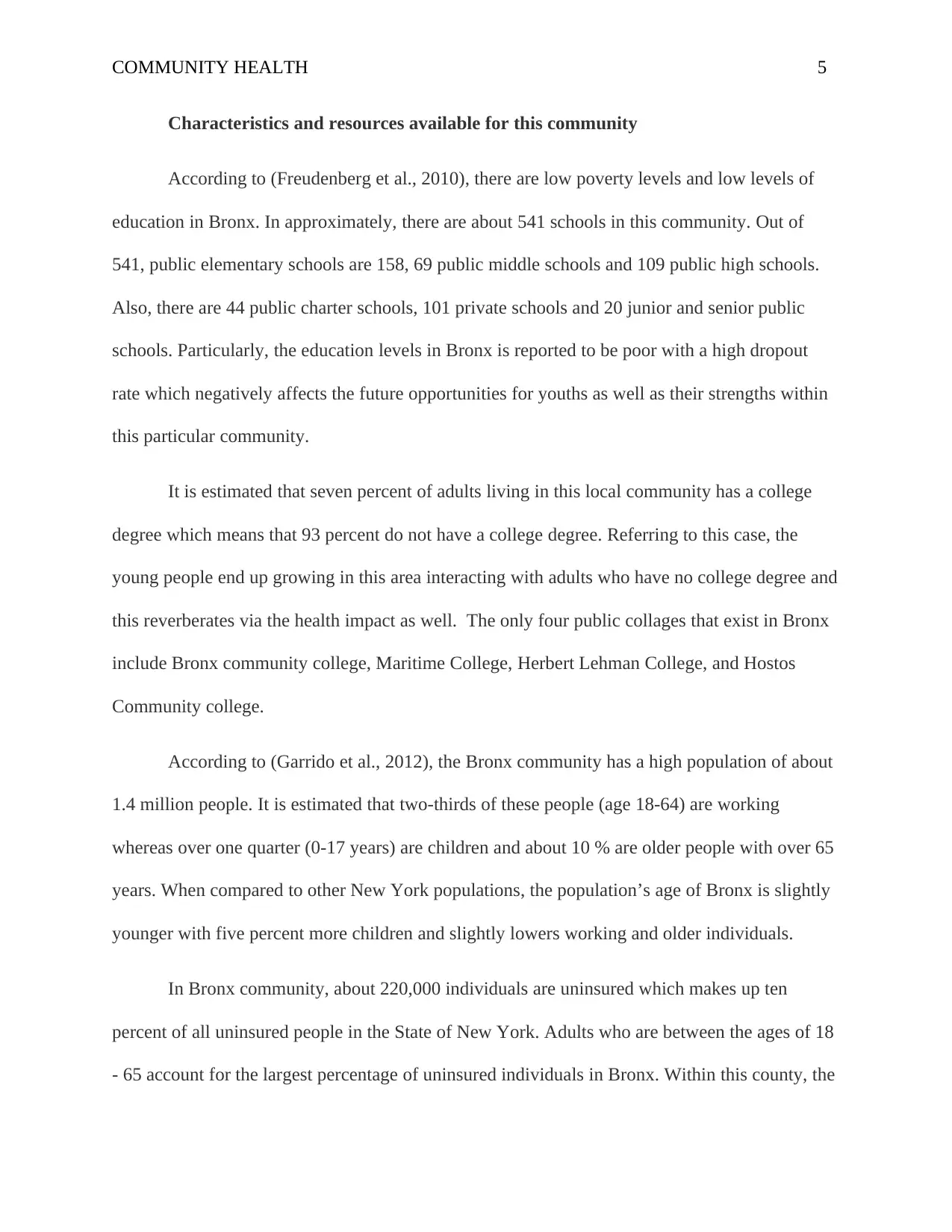
COMMUNITY HEALTH 5
Characteristics and resources available for this community
According to (Freudenberg et al., 2010), there are low poverty levels and low levels of
education in Bronx. In approximately, there are about 541 schools in this community. Out of
541, public elementary schools are 158, 69 public middle schools and 109 public high schools.
Also, there are 44 public charter schools, 101 private schools and 20 junior and senior public
schools. Particularly, the education levels in Bronx is reported to be poor with a high dropout
rate which negatively affects the future opportunities for youths as well as their strengths within
this particular community.
It is estimated that seven percent of adults living in this local community has a college
degree which means that 93 percent do not have a college degree. Referring to this case, the
young people end up growing in this area interacting with adults who have no college degree and
this reverberates via the health impact as well. The only four public collages that exist in Bronx
include Bronx community college, Maritime College, Herbert Lehman College, and Hostos
Community college.
According to (Garrido et al., 2012), the Bronx community has a high population of about
1.4 million people. It is estimated that two-thirds of these people (age 18-64) are working
whereas over one quarter (0-17 years) are children and about 10 % are older people with over 65
years. When compared to other New York populations, the population’s age of Bronx is slightly
younger with five percent more children and slightly lowers working and older individuals.
In Bronx community, about 220,000 individuals are uninsured which makes up ten
percent of all uninsured people in the State of New York. Adults who are between the ages of 18
- 65 account for the largest percentage of uninsured individuals in Bronx. Within this county, the
Characteristics and resources available for this community
According to (Freudenberg et al., 2010), there are low poverty levels and low levels of
education in Bronx. In approximately, there are about 541 schools in this community. Out of
541, public elementary schools are 158, 69 public middle schools and 109 public high schools.
Also, there are 44 public charter schools, 101 private schools and 20 junior and senior public
schools. Particularly, the education levels in Bronx is reported to be poor with a high dropout
rate which negatively affects the future opportunities for youths as well as their strengths within
this particular community.
It is estimated that seven percent of adults living in this local community has a college
degree which means that 93 percent do not have a college degree. Referring to this case, the
young people end up growing in this area interacting with adults who have no college degree and
this reverberates via the health impact as well. The only four public collages that exist in Bronx
include Bronx community college, Maritime College, Herbert Lehman College, and Hostos
Community college.
According to (Garrido et al., 2012), the Bronx community has a high population of about
1.4 million people. It is estimated that two-thirds of these people (age 18-64) are working
whereas over one quarter (0-17 years) are children and about 10 % are older people with over 65
years. When compared to other New York populations, the population’s age of Bronx is slightly
younger with five percent more children and slightly lowers working and older individuals.
In Bronx community, about 220,000 individuals are uninsured which makes up ten
percent of all uninsured people in the State of New York. Adults who are between the ages of 18
- 65 account for the largest percentage of uninsured individuals in Bronx. Within this county, the
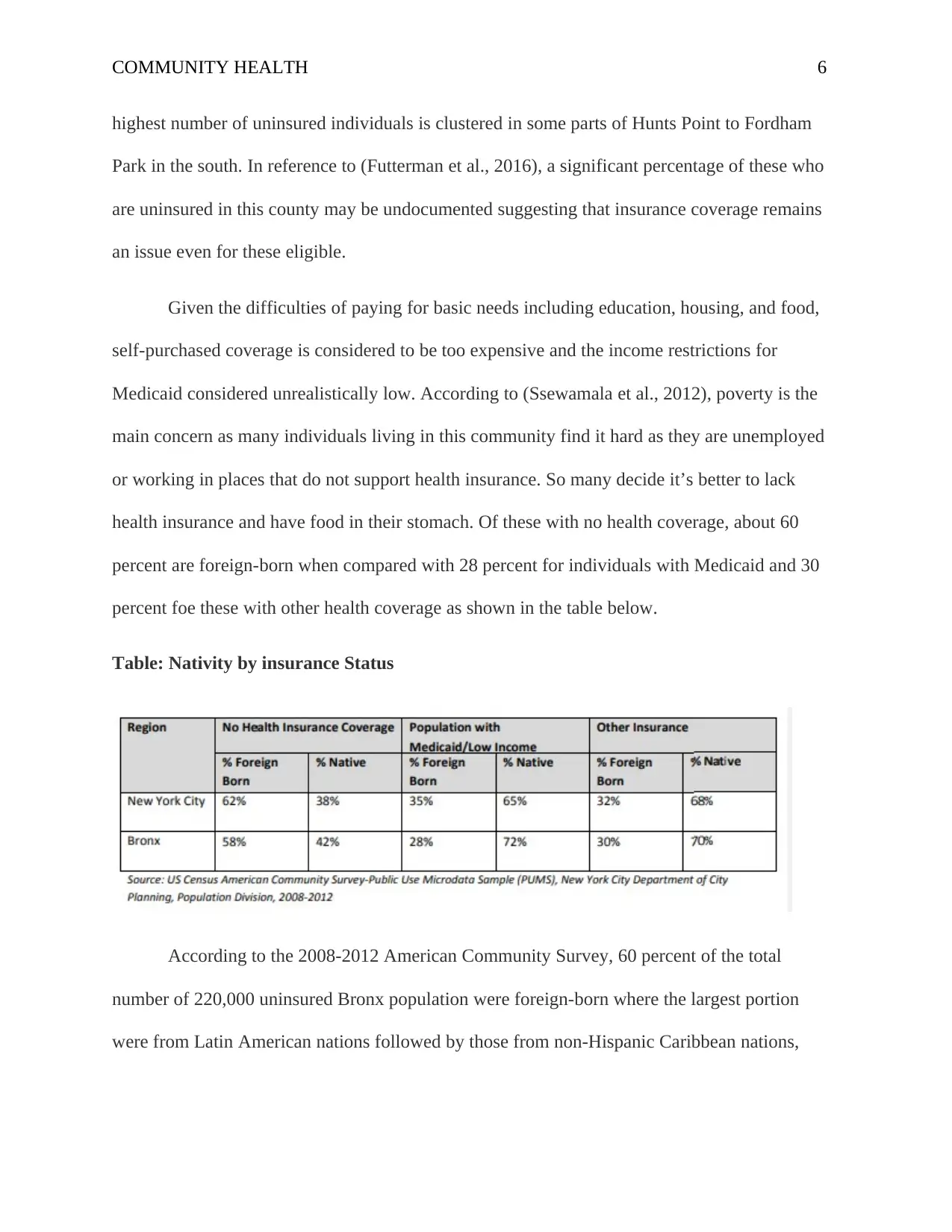
COMMUNITY HEALTH 6
highest number of uninsured individuals is clustered in some parts of Hunts Point to Fordham
Park in the south. In reference to (Futterman et al., 2016), a significant percentage of these who
are uninsured in this county may be undocumented suggesting that insurance coverage remains
an issue even for these eligible.
Given the difficulties of paying for basic needs including education, housing, and food,
self-purchased coverage is considered to be too expensive and the income restrictions for
Medicaid considered unrealistically low. According to (Ssewamala et al., 2012), poverty is the
main concern as many individuals living in this community find it hard as they are unemployed
or working in places that do not support health insurance. So many decide it’s better to lack
health insurance and have food in their stomach. Of these with no health coverage, about 60
percent are foreign-born when compared with 28 percent for individuals with Medicaid and 30
percent foe these with other health coverage as shown in the table below.
Table: Nativity by insurance Status
According to the 2008-2012 American Community Survey, 60 percent of the total
number of 220,000 uninsured Bronx population were foreign-born where the largest portion
were from Latin American nations followed by those from non-Hispanic Caribbean nations,
highest number of uninsured individuals is clustered in some parts of Hunts Point to Fordham
Park in the south. In reference to (Futterman et al., 2016), a significant percentage of these who
are uninsured in this county may be undocumented suggesting that insurance coverage remains
an issue even for these eligible.
Given the difficulties of paying for basic needs including education, housing, and food,
self-purchased coverage is considered to be too expensive and the income restrictions for
Medicaid considered unrealistically low. According to (Ssewamala et al., 2012), poverty is the
main concern as many individuals living in this community find it hard as they are unemployed
or working in places that do not support health insurance. So many decide it’s better to lack
health insurance and have food in their stomach. Of these with no health coverage, about 60
percent are foreign-born when compared with 28 percent for individuals with Medicaid and 30
percent foe these with other health coverage as shown in the table below.
Table: Nativity by insurance Status
According to the 2008-2012 American Community Survey, 60 percent of the total
number of 220,000 uninsured Bronx population were foreign-born where the largest portion
were from Latin American nations followed by those from non-Hispanic Caribbean nations,
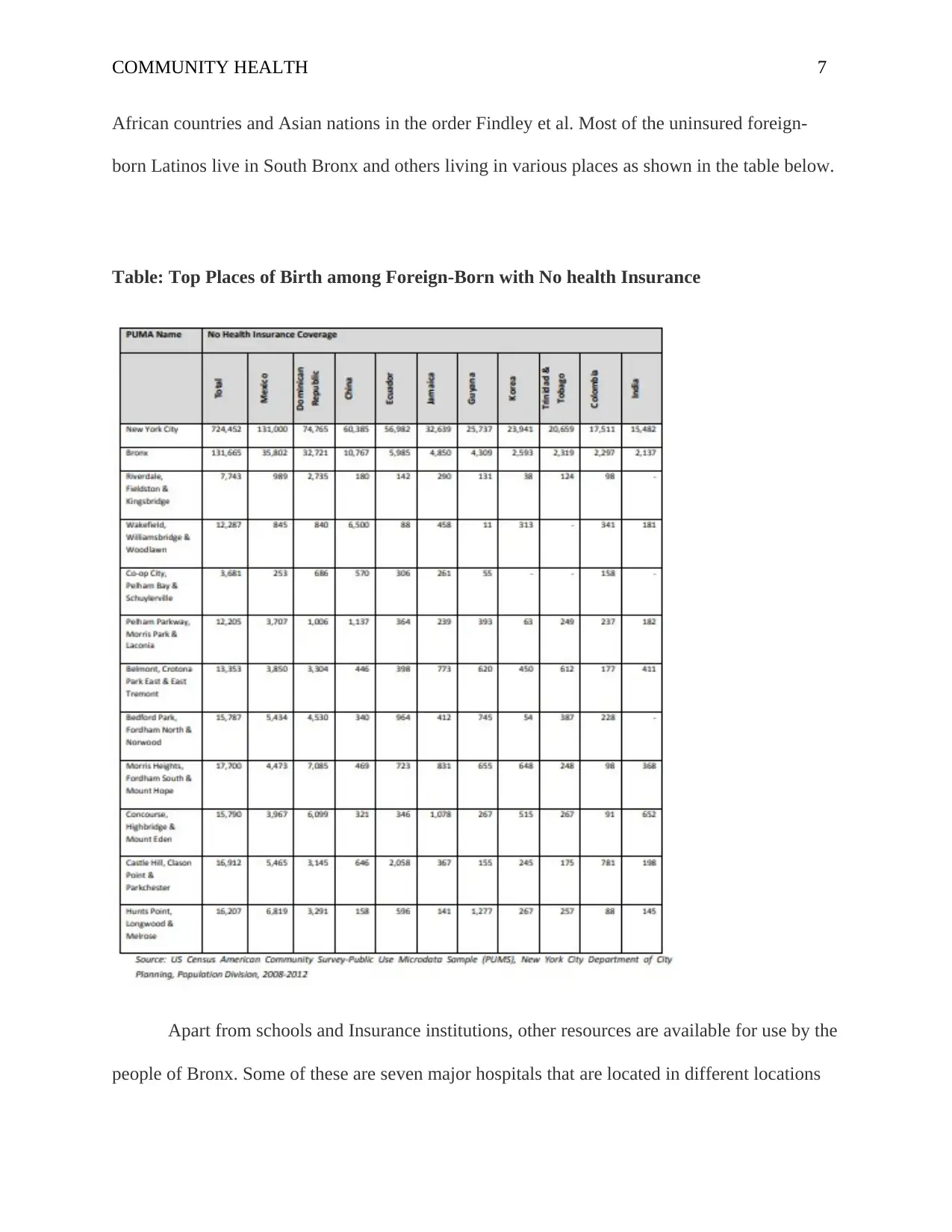
COMMUNITY HEALTH 7
African countries and Asian nations in the order Findley et al. Most of the uninsured foreign-
born Latinos live in South Bronx and others living in various places as shown in the table below.
Table: Top Places of Birth among Foreign-Born with No health Insurance
Apart from schools and Insurance institutions, other resources are available for use by the
people of Bronx. Some of these are seven major hospitals that are located in different locations
African countries and Asian nations in the order Findley et al. Most of the uninsured foreign-
born Latinos live in South Bronx and others living in various places as shown in the table below.
Table: Top Places of Birth among Foreign-Born with No health Insurance
Apart from schools and Insurance institutions, other resources are available for use by the
people of Bronx. Some of these are seven major hospitals that are located in different locations
Paraphrase This Document
Need a fresh take? Get an instant paraphrase of this document with our AI Paraphraser
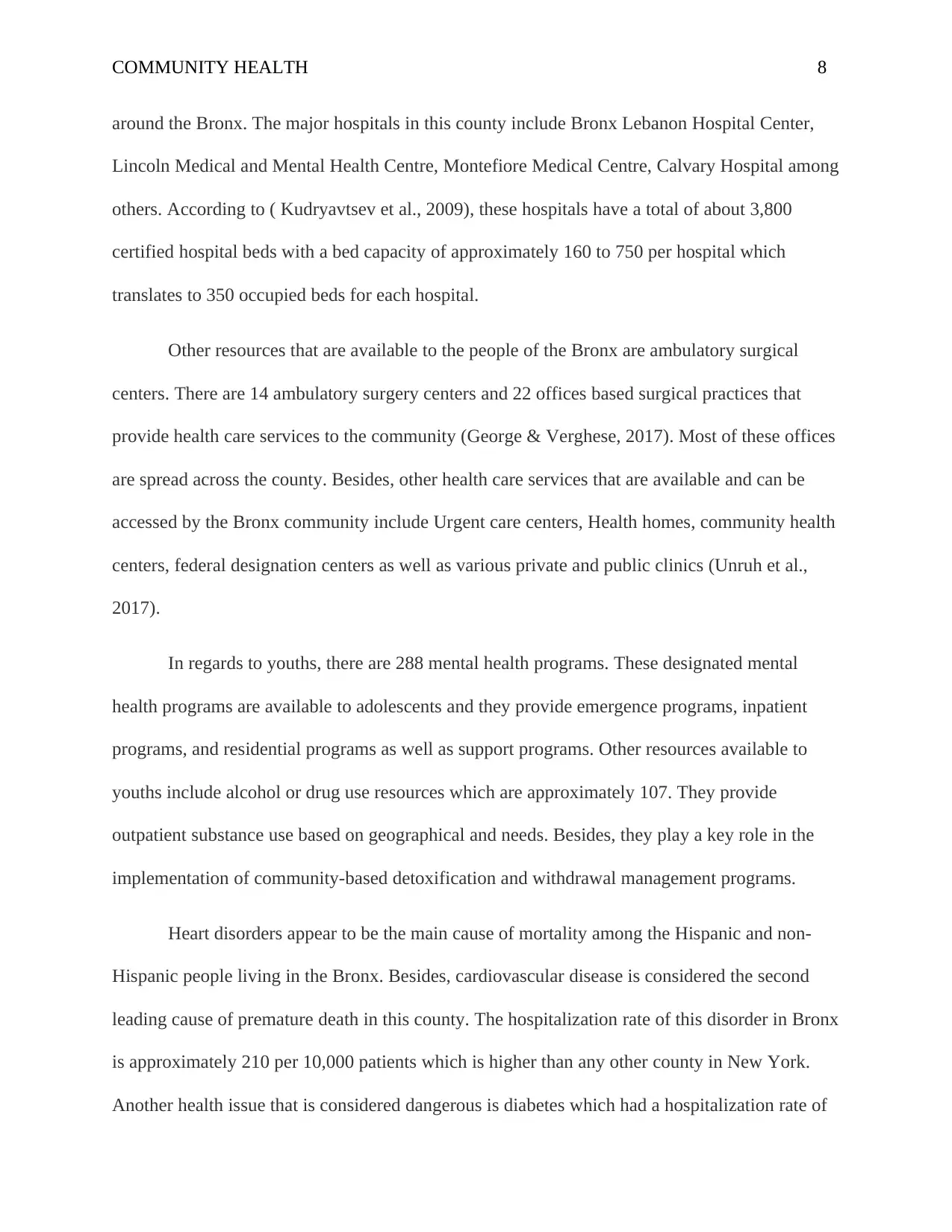
COMMUNITY HEALTH 8
around the Bronx. The major hospitals in this county include Bronx Lebanon Hospital Center,
Lincoln Medical and Mental Health Centre, Montefiore Medical Centre, Calvary Hospital among
others. According to ( Kudryavtsev et al., 2009), these hospitals have a total of about 3,800
certified hospital beds with a bed capacity of approximately 160 to 750 per hospital which
translates to 350 occupied beds for each hospital.
Other resources that are available to the people of the Bronx are ambulatory surgical
centers. There are 14 ambulatory surgery centers and 22 offices based surgical practices that
provide health care services to the community (George & Verghese, 2017). Most of these offices
are spread across the county. Besides, other health care services that are available and can be
accessed by the Bronx community include Urgent care centers, Health homes, community health
centers, federal designation centers as well as various private and public clinics (Unruh et al.,
2017).
In regards to youths, there are 288 mental health programs. These designated mental
health programs are available to adolescents and they provide emergence programs, inpatient
programs, and residential programs as well as support programs. Other resources available to
youths include alcohol or drug use resources which are approximately 107. They provide
outpatient substance use based on geographical and needs. Besides, they play a key role in the
implementation of community-based detoxification and withdrawal management programs.
Heart disorders appear to be the main cause of mortality among the Hispanic and non-
Hispanic people living in the Bronx. Besides, cardiovascular disease is considered the second
leading cause of premature death in this county. The hospitalization rate of this disorder in Bronx
is approximately 210 per 10,000 patients which is higher than any other county in New York.
Another health issue that is considered dangerous is diabetes which had a hospitalization rate of
around the Bronx. The major hospitals in this county include Bronx Lebanon Hospital Center,
Lincoln Medical and Mental Health Centre, Montefiore Medical Centre, Calvary Hospital among
others. According to ( Kudryavtsev et al., 2009), these hospitals have a total of about 3,800
certified hospital beds with a bed capacity of approximately 160 to 750 per hospital which
translates to 350 occupied beds for each hospital.
Other resources that are available to the people of the Bronx are ambulatory surgical
centers. There are 14 ambulatory surgery centers and 22 offices based surgical practices that
provide health care services to the community (George & Verghese, 2017). Most of these offices
are spread across the county. Besides, other health care services that are available and can be
accessed by the Bronx community include Urgent care centers, Health homes, community health
centers, federal designation centers as well as various private and public clinics (Unruh et al.,
2017).
In regards to youths, there are 288 mental health programs. These designated mental
health programs are available to adolescents and they provide emergence programs, inpatient
programs, and residential programs as well as support programs. Other resources available to
youths include alcohol or drug use resources which are approximately 107. They provide
outpatient substance use based on geographical and needs. Besides, they play a key role in the
implementation of community-based detoxification and withdrawal management programs.
Heart disorders appear to be the main cause of mortality among the Hispanic and non-
Hispanic people living in the Bronx. Besides, cardiovascular disease is considered the second
leading cause of premature death in this county. The hospitalization rate of this disorder in Bronx
is approximately 210 per 10,000 patients which is higher than any other county in New York.
Another health issue that is considered dangerous is diabetes which had a hospitalization rate of
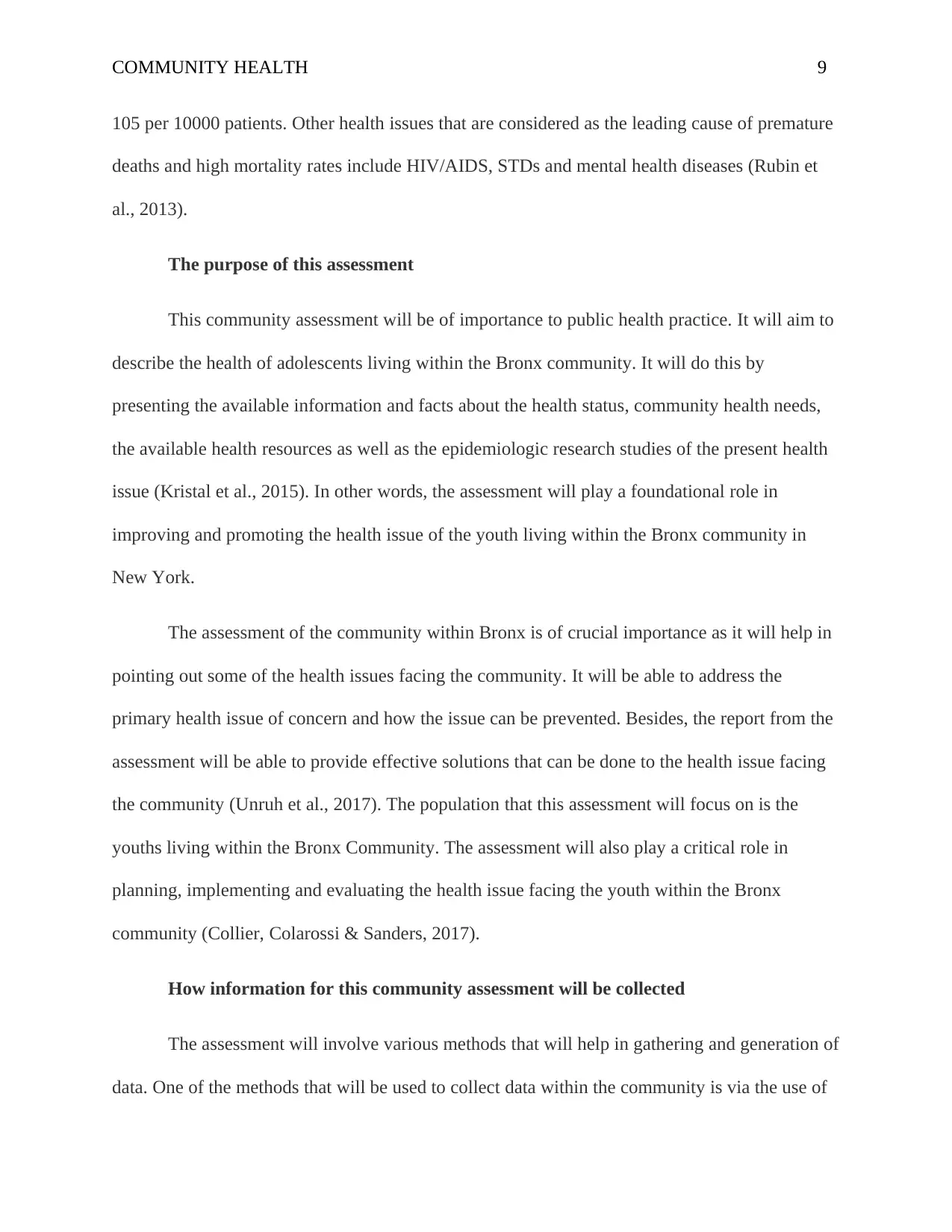
COMMUNITY HEALTH 9
105 per 10000 patients. Other health issues that are considered as the leading cause of premature
deaths and high mortality rates include HIV/AIDS, STDs and mental health diseases (Rubin et
al., 2013).
The purpose of this assessment
This community assessment will be of importance to public health practice. It will aim to
describe the health of adolescents living within the Bronx community. It will do this by
presenting the available information and facts about the health status, community health needs,
the available health resources as well as the epidemiologic research studies of the present health
issue (Kristal et al., 2015). In other words, the assessment will play a foundational role in
improving and promoting the health issue of the youth living within the Bronx community in
New York.
The assessment of the community within Bronx is of crucial importance as it will help in
pointing out some of the health issues facing the community. It will be able to address the
primary health issue of concern and how the issue can be prevented. Besides, the report from the
assessment will be able to provide effective solutions that can be done to the health issue facing
the community (Unruh et al., 2017). The population that this assessment will focus on is the
youths living within the Bronx Community. The assessment will also play a critical role in
planning, implementing and evaluating the health issue facing the youth within the Bronx
community (Collier, Colarossi & Sanders, 2017).
How information for this community assessment will be collected
The assessment will involve various methods that will help in gathering and generation of
data. One of the methods that will be used to collect data within the community is via the use of
105 per 10000 patients. Other health issues that are considered as the leading cause of premature
deaths and high mortality rates include HIV/AIDS, STDs and mental health diseases (Rubin et
al., 2013).
The purpose of this assessment
This community assessment will be of importance to public health practice. It will aim to
describe the health of adolescents living within the Bronx community. It will do this by
presenting the available information and facts about the health status, community health needs,
the available health resources as well as the epidemiologic research studies of the present health
issue (Kristal et al., 2015). In other words, the assessment will play a foundational role in
improving and promoting the health issue of the youth living within the Bronx community in
New York.
The assessment of the community within Bronx is of crucial importance as it will help in
pointing out some of the health issues facing the community. It will be able to address the
primary health issue of concern and how the issue can be prevented. Besides, the report from the
assessment will be able to provide effective solutions that can be done to the health issue facing
the community (Unruh et al., 2017). The population that this assessment will focus on is the
youths living within the Bronx Community. The assessment will also play a critical role in
planning, implementing and evaluating the health issue facing the youth within the Bronx
community (Collier, Colarossi & Sanders, 2017).
How information for this community assessment will be collected
The assessment will involve various methods that will help in gathering and generation of
data. One of the methods that will be used to collect data within the community is via the use of
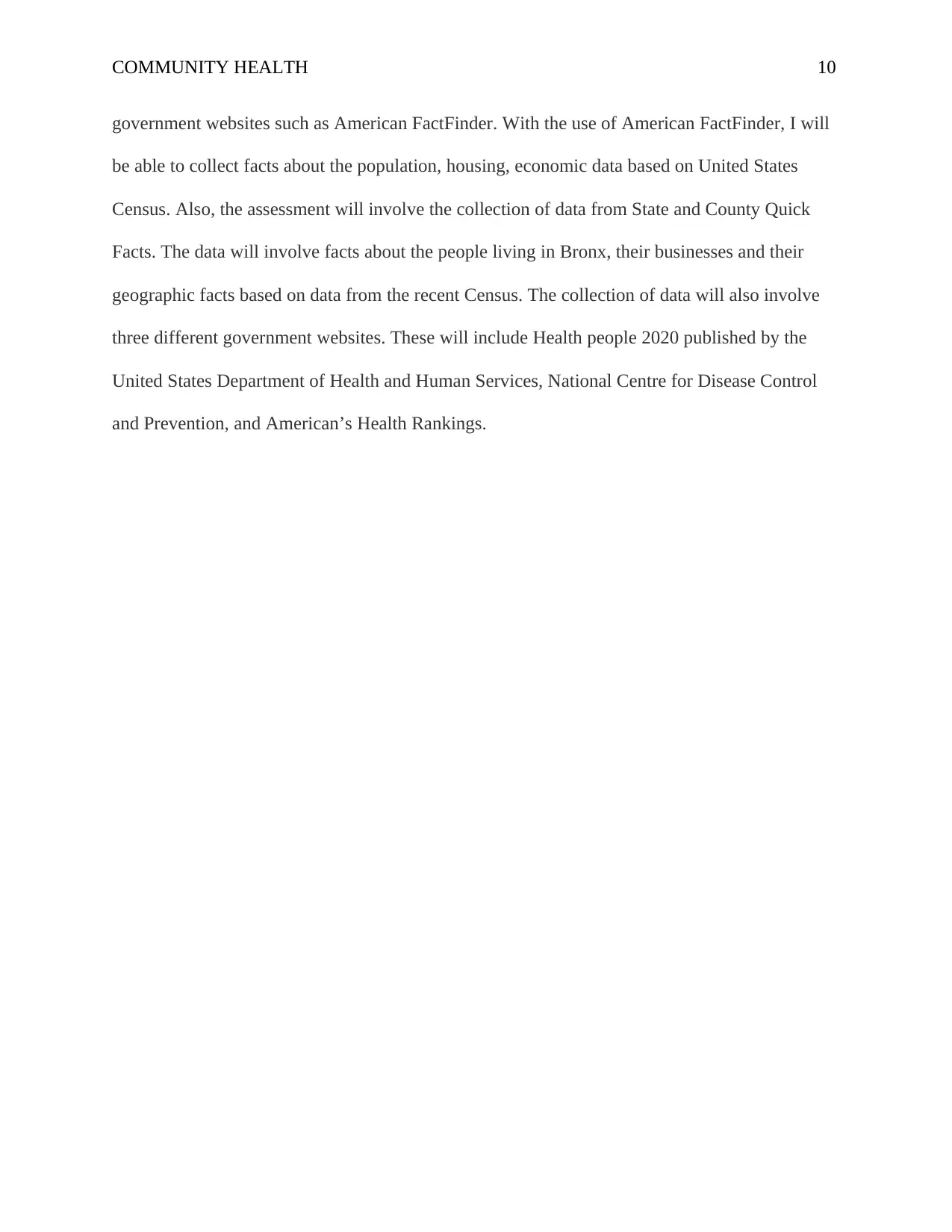
COMMUNITY HEALTH 10
government websites such as American FactFinder. With the use of American FactFinder, I will
be able to collect facts about the population, housing, economic data based on United States
Census. Also, the assessment will involve the collection of data from State and County Quick
Facts. The data will involve facts about the people living in Bronx, their businesses and their
geographic facts based on data from the recent Census. The collection of data will also involve
three different government websites. These will include Health people 2020 published by the
United States Department of Health and Human Services, National Centre for Disease Control
and Prevention, and American’s Health Rankings.
government websites such as American FactFinder. With the use of American FactFinder, I will
be able to collect facts about the population, housing, economic data based on United States
Census. Also, the assessment will involve the collection of data from State and County Quick
Facts. The data will involve facts about the people living in Bronx, their businesses and their
geographic facts based on data from the recent Census. The collection of data will also involve
three different government websites. These will include Health people 2020 published by the
United States Department of Health and Human Services, National Centre for Disease Control
and Prevention, and American’s Health Rankings.
Secure Best Marks with AI Grader
Need help grading? Try our AI Grader for instant feedback on your assignments.
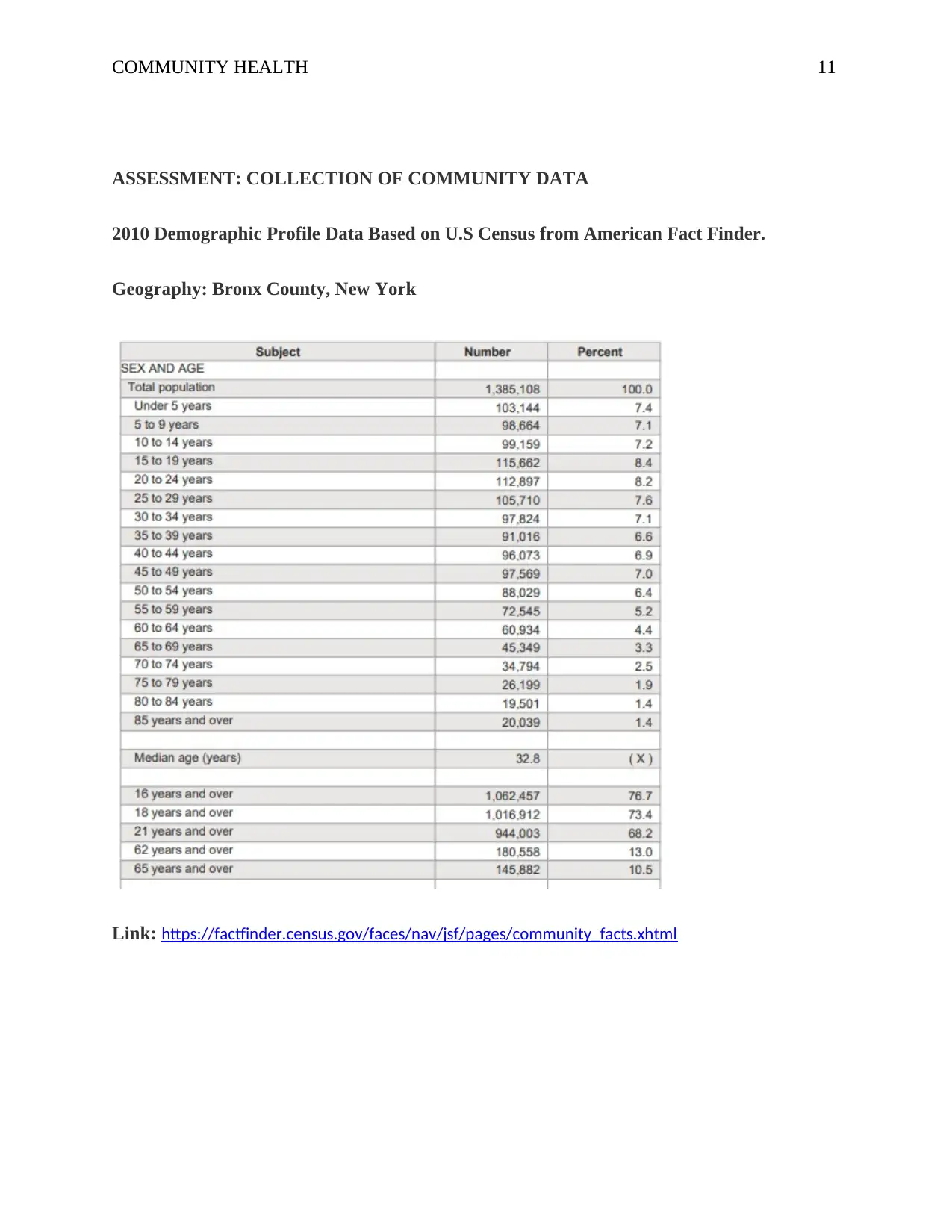
COMMUNITY HEALTH 11
ASSESSMENT: COLLECTION OF COMMUNITY DATA
2010 Demographic Profile Data Based on U.S Census from American Fact Finder.
Geography: Bronx County, New York
Link: https://factfinder.census.gov/faces/nav/jsf/pages/community_facts.xhtml
ASSESSMENT: COLLECTION OF COMMUNITY DATA
2010 Demographic Profile Data Based on U.S Census from American Fact Finder.
Geography: Bronx County, New York
Link: https://factfinder.census.gov/faces/nav/jsf/pages/community_facts.xhtml
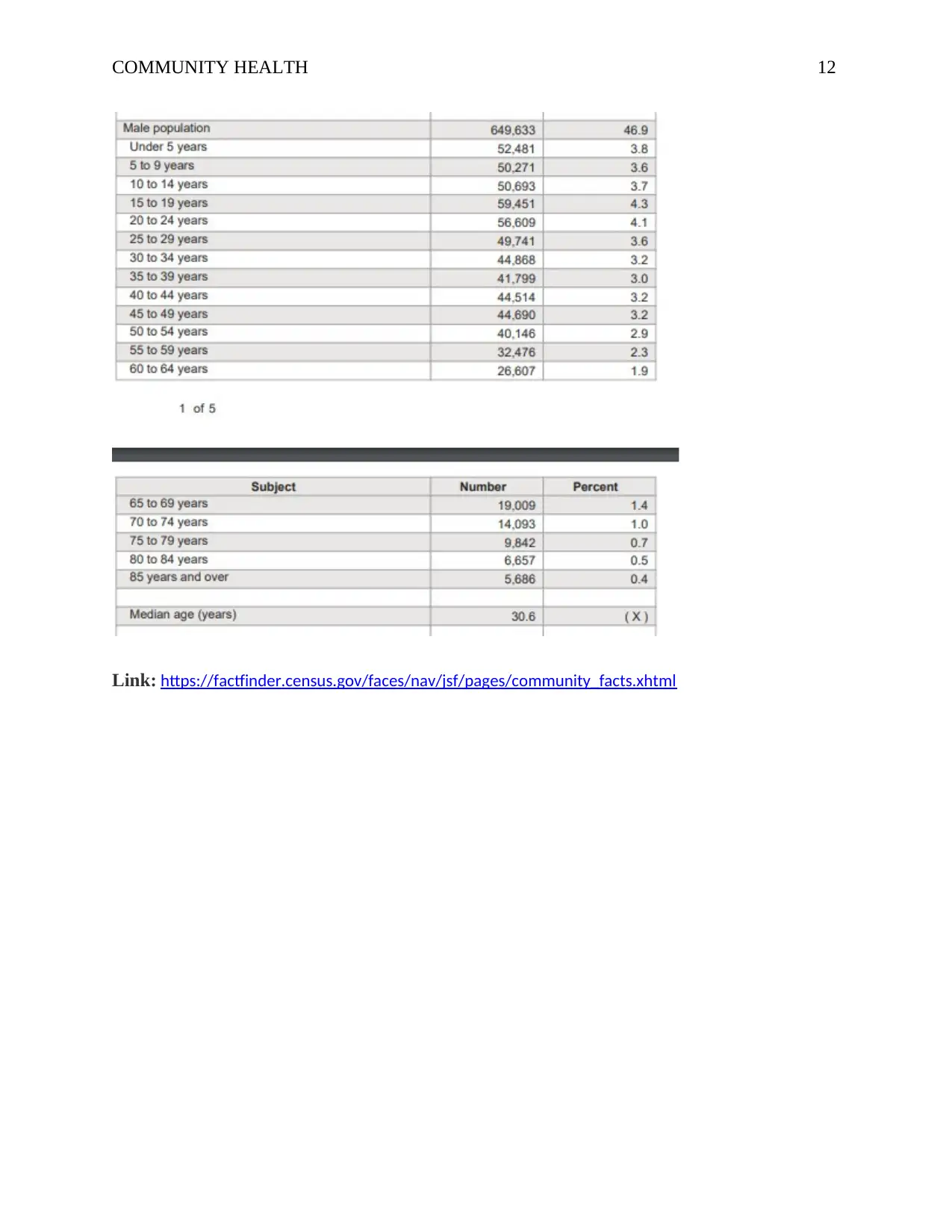
COMMUNITY HEALTH 12
Link: https://factfinder.census.gov/faces/nav/jsf/pages/community_facts.xhtml
Link: https://factfinder.census.gov/faces/nav/jsf/pages/community_facts.xhtml
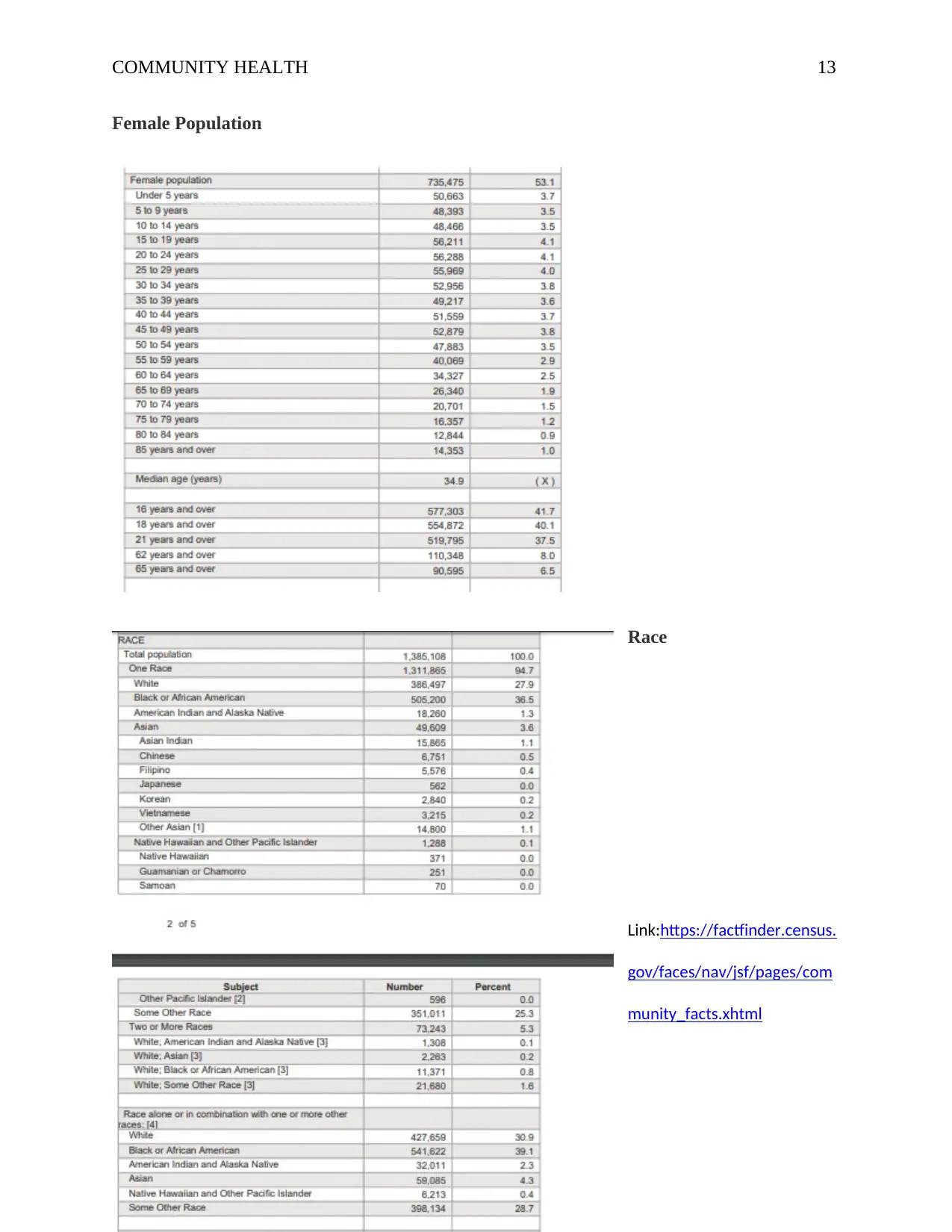
COMMUNITY HEALTH 13
Female Population
Race
Link:https://factfinder.census.
gov/faces/nav/jsf/pages/com
munity_facts.xhtml
Female Population
Race
Link:https://factfinder.census.
gov/faces/nav/jsf/pages/com
munity_facts.xhtml
Paraphrase This Document
Need a fresh take? Get an instant paraphrase of this document with our AI Paraphraser

COMMUNITY HEALTH 14
Link:https://factfinder.census.gov/faces/nav/jsf/pages/community_facts.xhtml
Relationships
Link:https://factfinder.census.gov/faces/nav/jsf/pages/community_facts.xhtml
Relationships
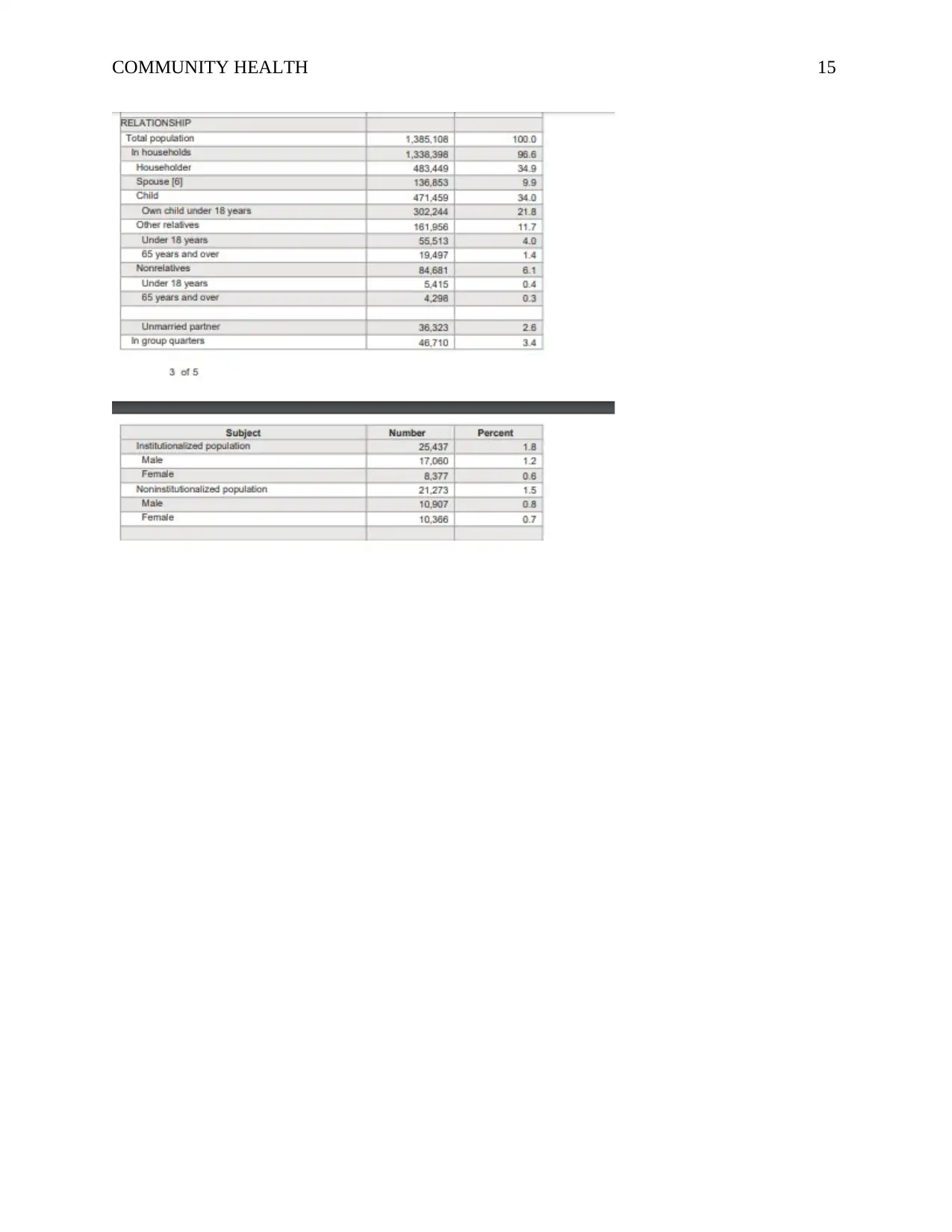
COMMUNITY HEALTH 15

COMMUNITY HEALTH 16
Link:https://factfinder.census.gov/faces/nav/jsf/pages/community_facts.xhtml
Link:https://factfinder.census.gov/faces/nav/jsf/pages/community_facts.xhtml
Secure Best Marks with AI Grader
Need help grading? Try our AI Grader for instant feedback on your assignments.
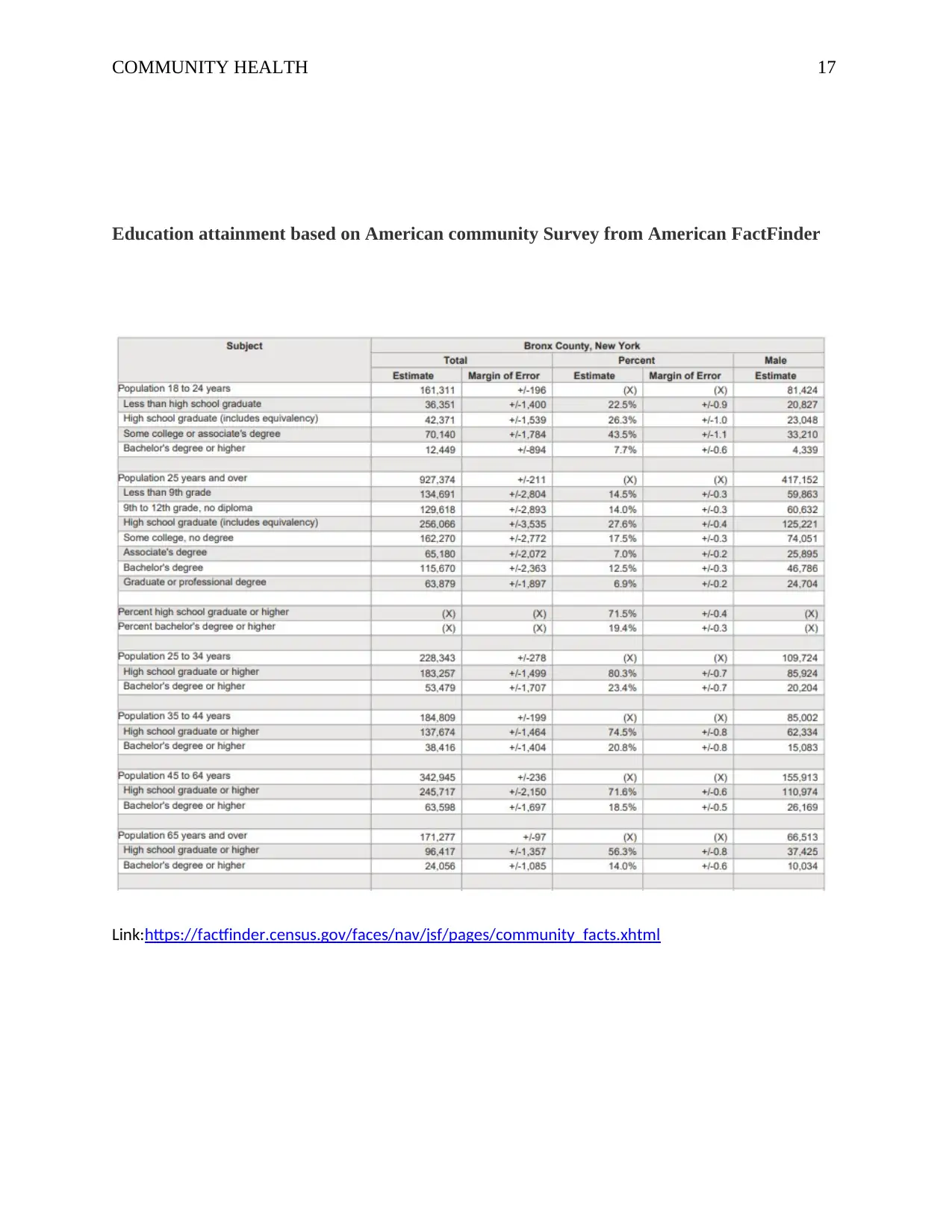
COMMUNITY HEALTH 17
Education attainment based on American community Survey from American FactFinder
Link:https://factfinder.census.gov/faces/nav/jsf/pages/community_facts.xhtml
Education attainment based on American community Survey from American FactFinder
Link:https://factfinder.census.gov/faces/nav/jsf/pages/community_facts.xhtml
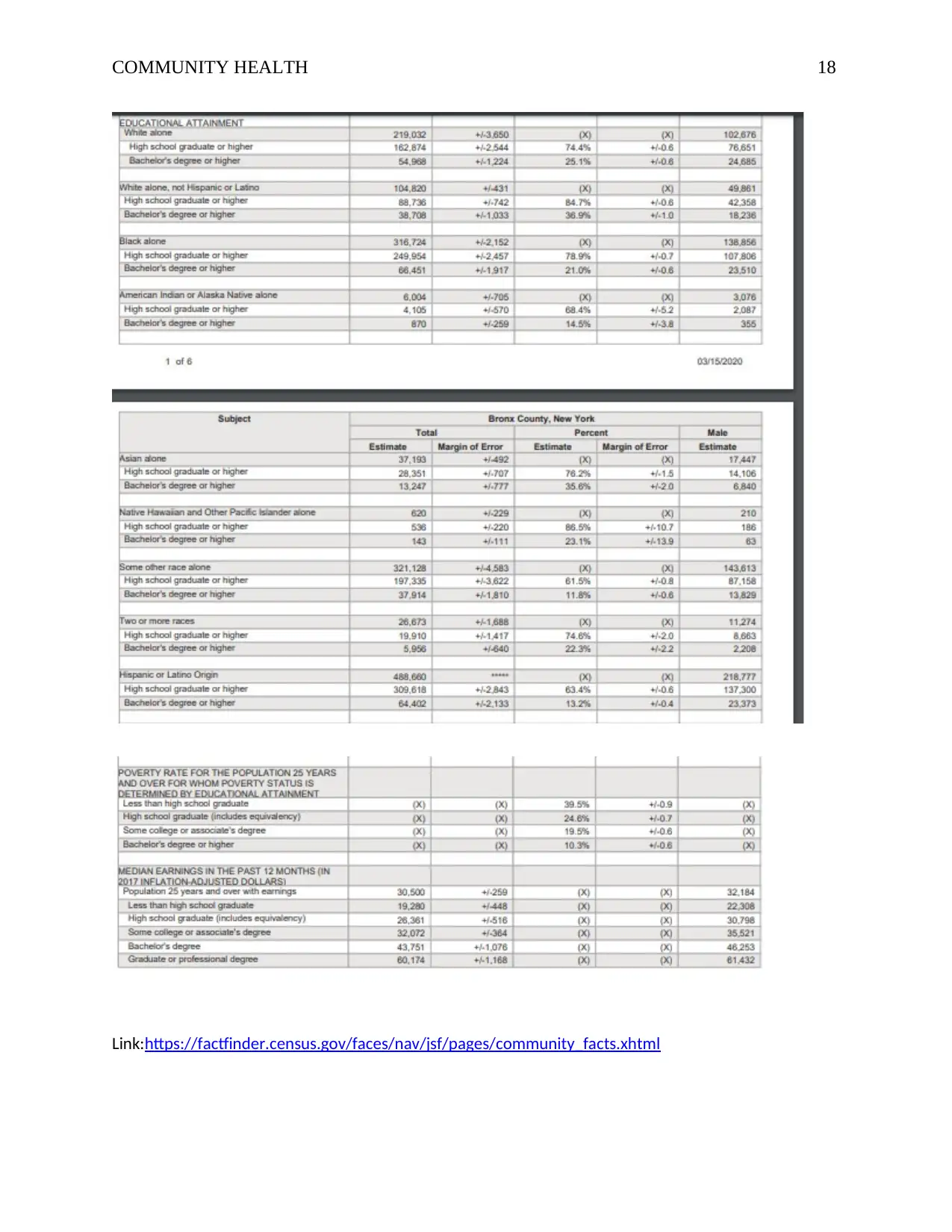
COMMUNITY HEALTH 18
Link:https://factfinder.census.gov/faces/nav/jsf/pages/community_facts.xhtml
Link:https://factfinder.census.gov/faces/nav/jsf/pages/community_facts.xhtml
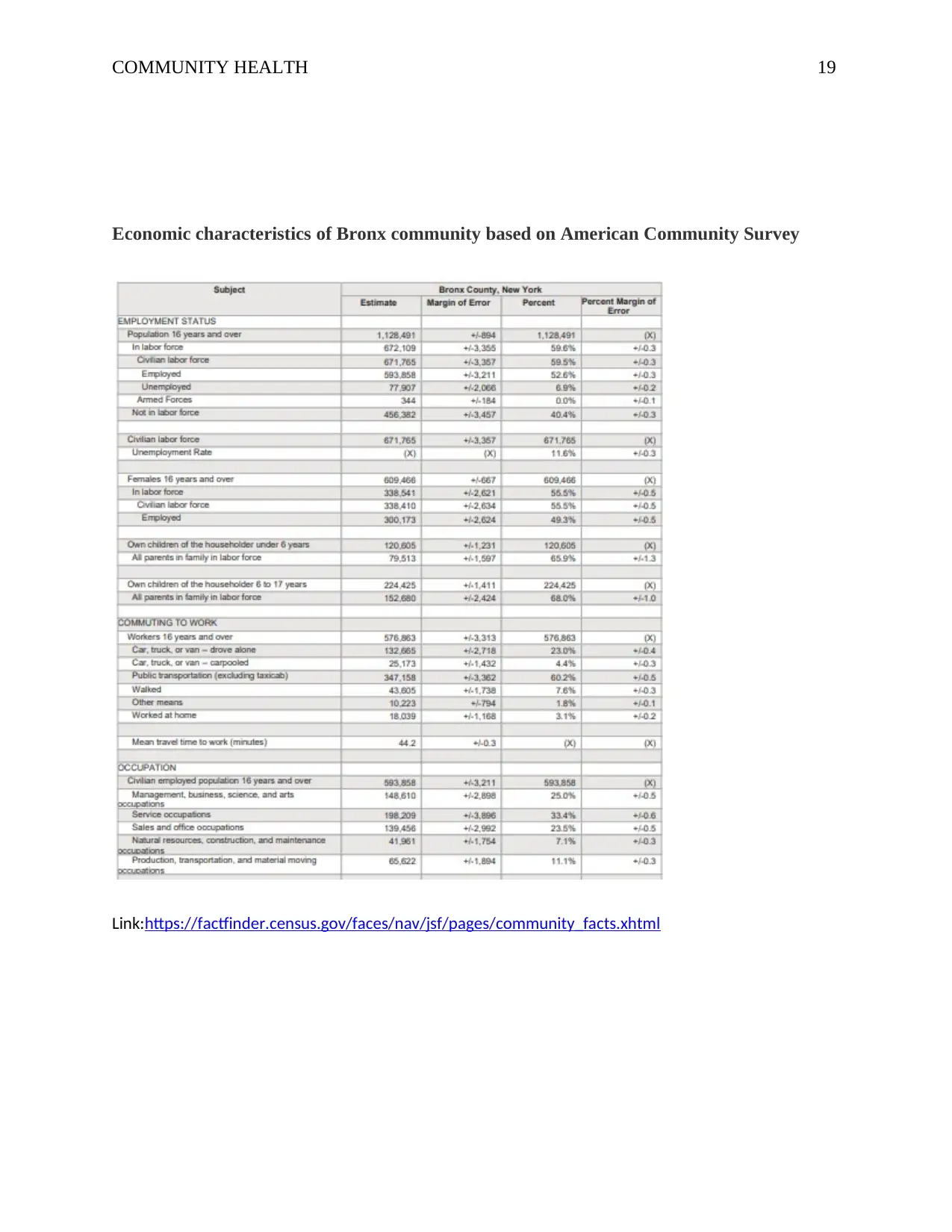
COMMUNITY HEALTH 19
Economic characteristics of Bronx community based on American Community Survey
Link:https://factfinder.census.gov/faces/nav/jsf/pages/community_facts.xhtml
Economic characteristics of Bronx community based on American Community Survey
Link:https://factfinder.census.gov/faces/nav/jsf/pages/community_facts.xhtml
Paraphrase This Document
Need a fresh take? Get an instant paraphrase of this document with our AI Paraphraser
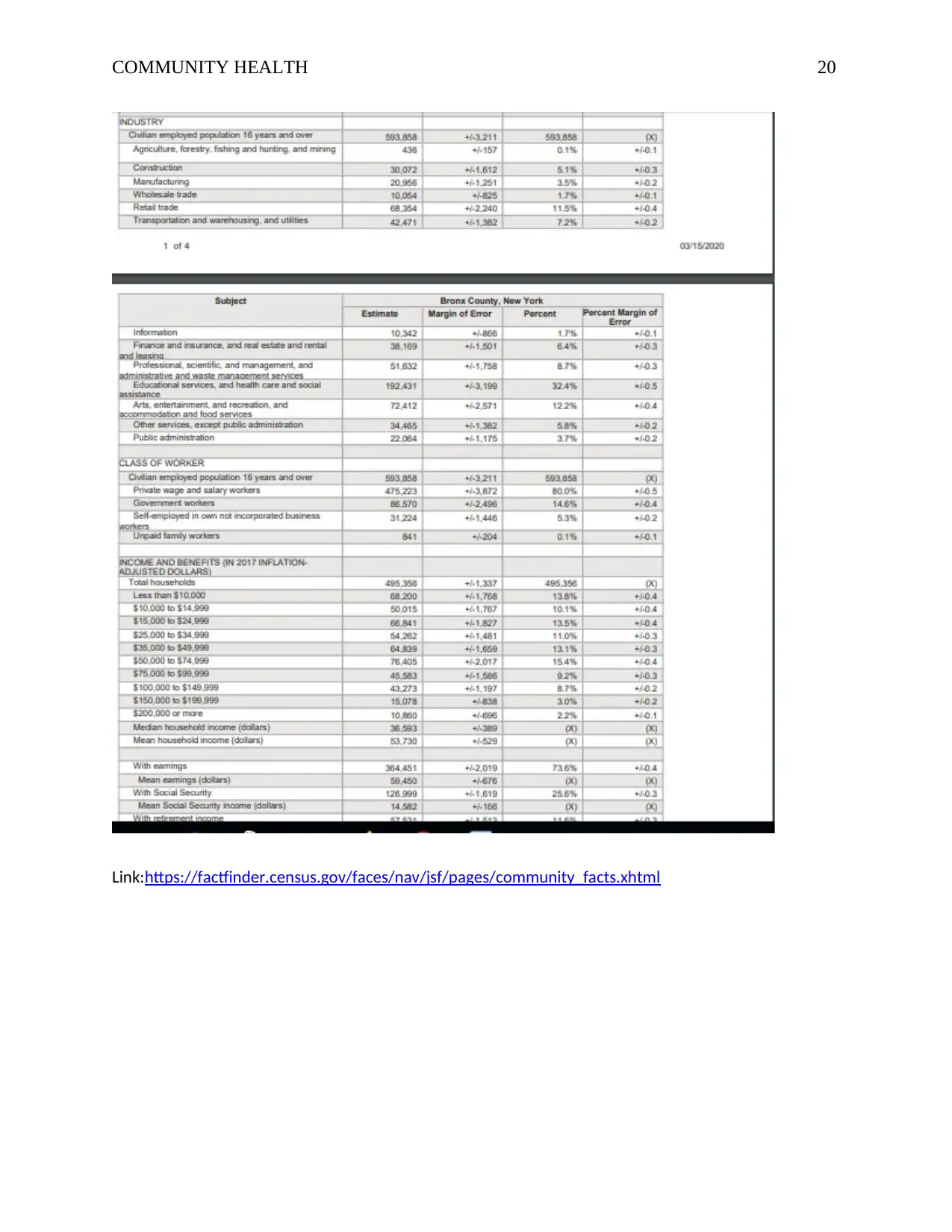
COMMUNITY HEALTH 20
Link:https://factfinder.census.gov/faces/nav/jsf/pages/community_facts.xhtml
Link:https://factfinder.census.gov/faces/nav/jsf/pages/community_facts.xhtml

COMMUNITY HEALTH 21
Link:https://factfinder.census.gov/faces/nav/jsf/pages/community_facts.xhtml
Link:https://factfinder.census.gov/faces/nav/jsf/pages/community_facts.xhtml
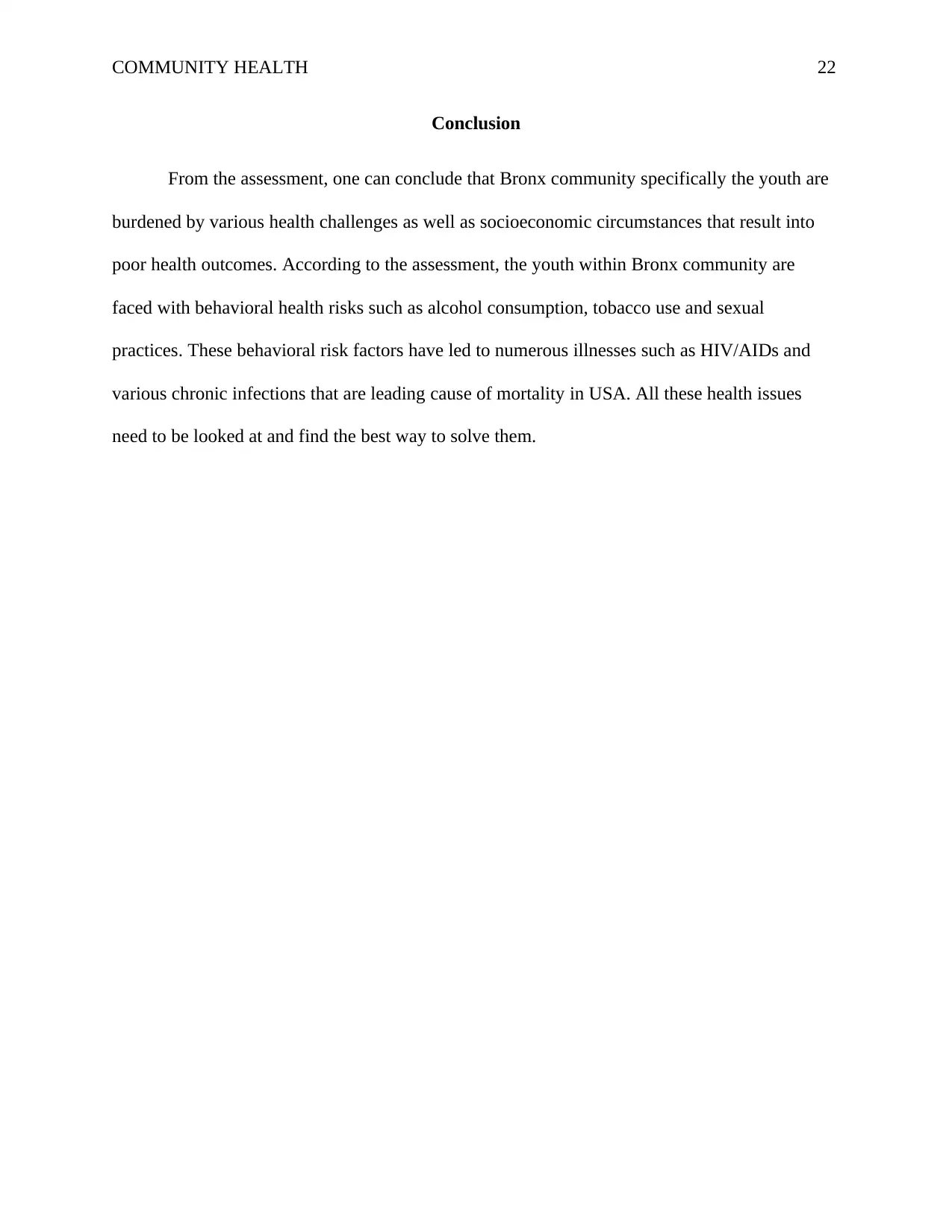
COMMUNITY HEALTH 22
Conclusion
From the assessment, one can conclude that Bronx community specifically the youth are
burdened by various health challenges as well as socioeconomic circumstances that result into
poor health outcomes. According to the assessment, the youth within Bronx community are
faced with behavioral health risks such as alcohol consumption, tobacco use and sexual
practices. These behavioral risk factors have led to numerous illnesses such as HIV/AIDs and
various chronic infections that are leading cause of mortality in USA. All these health issues
need to be looked at and find the best way to solve them.
Conclusion
From the assessment, one can conclude that Bronx community specifically the youth are
burdened by various health challenges as well as socioeconomic circumstances that result into
poor health outcomes. According to the assessment, the youth within Bronx community are
faced with behavioral health risks such as alcohol consumption, tobacco use and sexual
practices. These behavioral risk factors have led to numerous illnesses such as HIV/AIDs and
various chronic infections that are leading cause of mortality in USA. All these health issues
need to be looked at and find the best way to solve them.
Secure Best Marks with AI Grader
Need help grading? Try our AI Grader for instant feedback on your assignments.
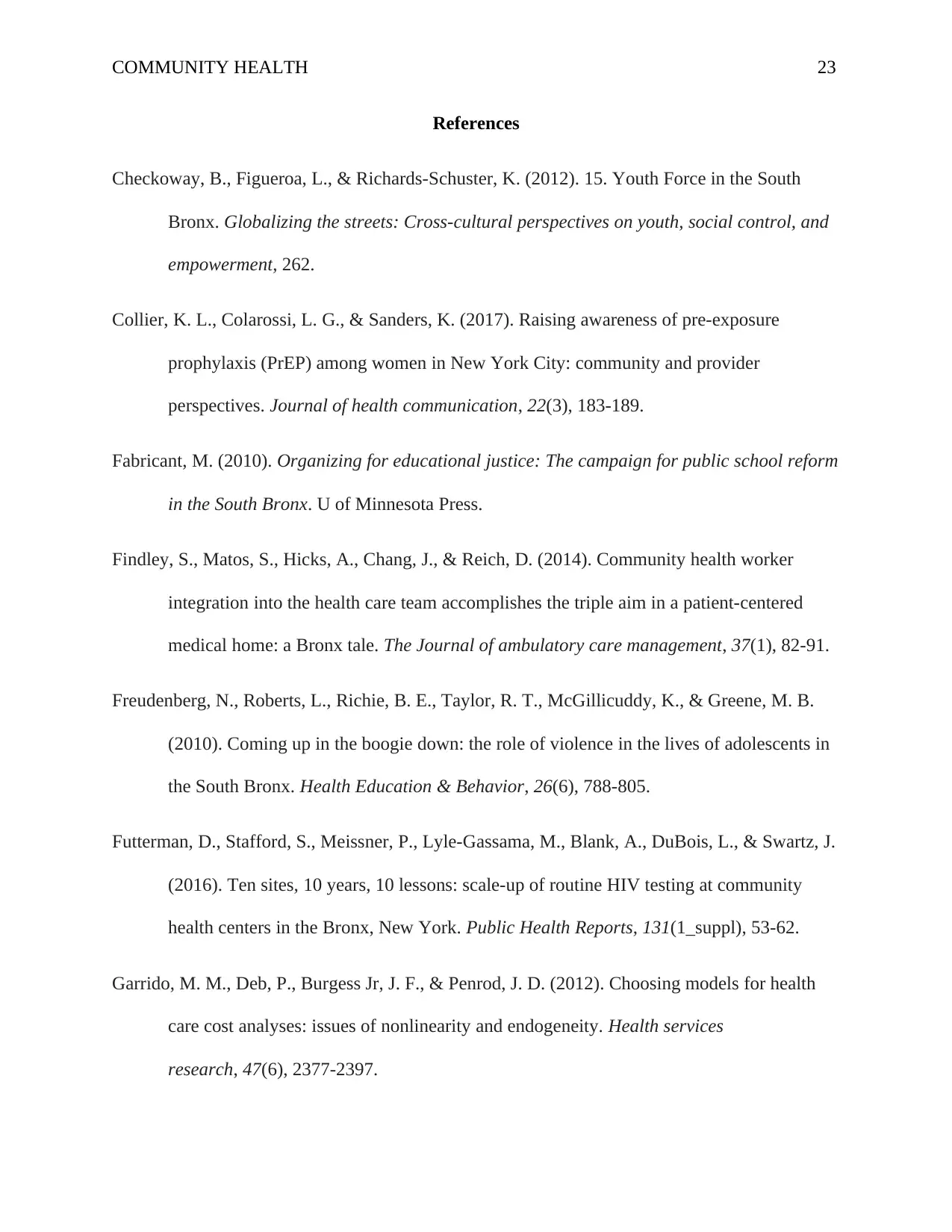
COMMUNITY HEALTH 23
References
Checkoway, B., Figueroa, L., & Richards-Schuster, K. (2012). 15. Youth Force in the South
Bronx. Globalizing the streets: Cross-cultural perspectives on youth, social control, and
empowerment, 262.
Collier, K. L., Colarossi, L. G., & Sanders, K. (2017). Raising awareness of pre-exposure
prophylaxis (PrEP) among women in New York City: community and provider
perspectives. Journal of health communication, 22(3), 183-189.
Fabricant, M. (2010). Organizing for educational justice: The campaign for public school reform
in the South Bronx. U of Minnesota Press.
Findley, S., Matos, S., Hicks, A., Chang, J., & Reich, D. (2014). Community health worker
integration into the health care team accomplishes the triple aim in a patient-centered
medical home: a Bronx tale. The Journal of ambulatory care management, 37(1), 82-91.
Freudenberg, N., Roberts, L., Richie, B. E., Taylor, R. T., McGillicuddy, K., & Greene, M. B.
(2010). Coming up in the boogie down: the role of violence in the lives of adolescents in
the South Bronx. Health Education & Behavior, 26(6), 788-805.
Futterman, D., Stafford, S., Meissner, P., Lyle-Gassama, M., Blank, A., DuBois, L., & Swartz, J.
(2016). Ten sites, 10 years, 10 lessons: scale-up of routine HIV testing at community
health centers in the Bronx, New York. Public Health Reports, 131(1_suppl), 53-62.
Garrido, M. M., Deb, P., Burgess Jr, J. F., & Penrod, J. D. (2012). Choosing models for health
care cost analyses: issues of nonlinearity and endogeneity. Health services
research, 47(6), 2377-2397.
References
Checkoway, B., Figueroa, L., & Richards-Schuster, K. (2012). 15. Youth Force in the South
Bronx. Globalizing the streets: Cross-cultural perspectives on youth, social control, and
empowerment, 262.
Collier, K. L., Colarossi, L. G., & Sanders, K. (2017). Raising awareness of pre-exposure
prophylaxis (PrEP) among women in New York City: community and provider
perspectives. Journal of health communication, 22(3), 183-189.
Fabricant, M. (2010). Organizing for educational justice: The campaign for public school reform
in the South Bronx. U of Minnesota Press.
Findley, S., Matos, S., Hicks, A., Chang, J., & Reich, D. (2014). Community health worker
integration into the health care team accomplishes the triple aim in a patient-centered
medical home: a Bronx tale. The Journal of ambulatory care management, 37(1), 82-91.
Freudenberg, N., Roberts, L., Richie, B. E., Taylor, R. T., McGillicuddy, K., & Greene, M. B.
(2010). Coming up in the boogie down: the role of violence in the lives of adolescents in
the South Bronx. Health Education & Behavior, 26(6), 788-805.
Futterman, D., Stafford, S., Meissner, P., Lyle-Gassama, M., Blank, A., DuBois, L., & Swartz, J.
(2016). Ten sites, 10 years, 10 lessons: scale-up of routine HIV testing at community
health centers in the Bronx, New York. Public Health Reports, 131(1_suppl), 53-62.
Garrido, M. M., Deb, P., Burgess Jr, J. F., & Penrod, J. D. (2012). Choosing models for health
care cost analyses: issues of nonlinearity and endogeneity. Health services
research, 47(6), 2377-2397.
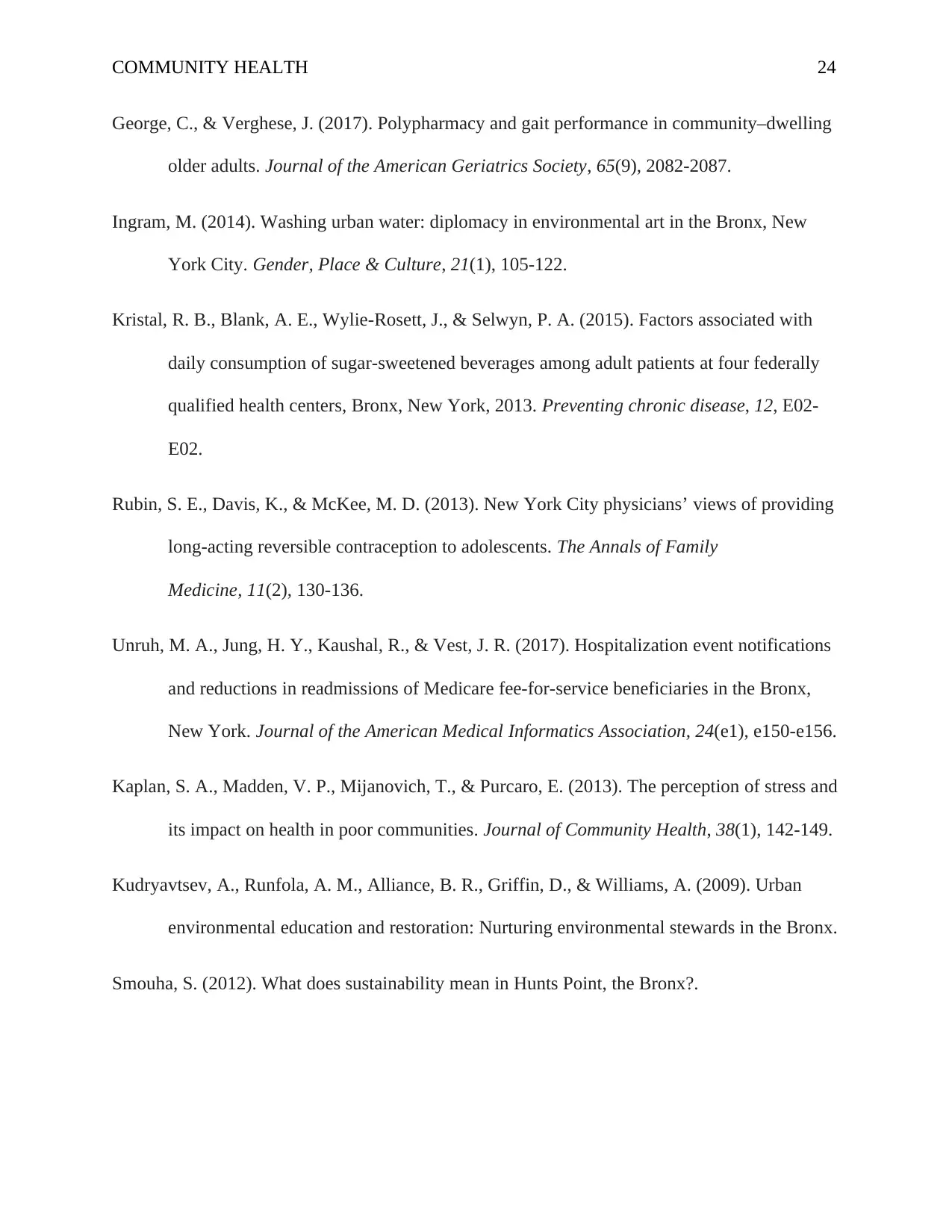
COMMUNITY HEALTH 24
George, C., & Verghese, J. (2017). Polypharmacy and gait performance in community–dwelling
older adults. Journal of the American Geriatrics Society, 65(9), 2082-2087.
Ingram, M. (2014). Washing urban water: diplomacy in environmental art in the Bronx, New
York City. Gender, Place & Culture, 21(1), 105-122.
Kristal, R. B., Blank, A. E., Wylie-Rosett, J., & Selwyn, P. A. (2015). Factors associated with
daily consumption of sugar-sweetened beverages among adult patients at four federally
qualified health centers, Bronx, New York, 2013. Preventing chronic disease, 12, E02-
E02.
Rubin, S. E., Davis, K., & McKee, M. D. (2013). New York City physicians’ views of providing
long-acting reversible contraception to adolescents. The Annals of Family
Medicine, 11(2), 130-136.
Unruh, M. A., Jung, H. Y., Kaushal, R., & Vest, J. R. (2017). Hospitalization event notifications
and reductions in readmissions of Medicare fee-for-service beneficiaries in the Bronx,
New York. Journal of the American Medical Informatics Association, 24(e1), e150-e156.
Kaplan, S. A., Madden, V. P., Mijanovich, T., & Purcaro, E. (2013). The perception of stress and
its impact on health in poor communities. Journal of Community Health, 38(1), 142-149.
Kudryavtsev, A., Runfola, A. M., Alliance, B. R., Griffin, D., & Williams, A. (2009). Urban
environmental education and restoration: Nurturing environmental stewards in the Bronx.
Smouha, S. (2012). What does sustainability mean in Hunts Point, the Bronx?.
George, C., & Verghese, J. (2017). Polypharmacy and gait performance in community–dwelling
older adults. Journal of the American Geriatrics Society, 65(9), 2082-2087.
Ingram, M. (2014). Washing urban water: diplomacy in environmental art in the Bronx, New
York City. Gender, Place & Culture, 21(1), 105-122.
Kristal, R. B., Blank, A. E., Wylie-Rosett, J., & Selwyn, P. A. (2015). Factors associated with
daily consumption of sugar-sweetened beverages among adult patients at four federally
qualified health centers, Bronx, New York, 2013. Preventing chronic disease, 12, E02-
E02.
Rubin, S. E., Davis, K., & McKee, M. D. (2013). New York City physicians’ views of providing
long-acting reversible contraception to adolescents. The Annals of Family
Medicine, 11(2), 130-136.
Unruh, M. A., Jung, H. Y., Kaushal, R., & Vest, J. R. (2017). Hospitalization event notifications
and reductions in readmissions of Medicare fee-for-service beneficiaries in the Bronx,
New York. Journal of the American Medical Informatics Association, 24(e1), e150-e156.
Kaplan, S. A., Madden, V. P., Mijanovich, T., & Purcaro, E. (2013). The perception of stress and
its impact on health in poor communities. Journal of Community Health, 38(1), 142-149.
Kudryavtsev, A., Runfola, A. M., Alliance, B. R., Griffin, D., & Williams, A. (2009). Urban
environmental education and restoration: Nurturing environmental stewards in the Bronx.
Smouha, S. (2012). What does sustainability mean in Hunts Point, the Bronx?.

COMMUNITY HEALTH 25
Ssewamala, F. M., Sperber, E., Blake, C. A., & Ilic, V. P. (2012). Increasing opportunities for
inner-city youth: The feasibility of an economic empowerment model in East Harlem and
the South Bronx, New York. Children and youth services review, 34(1), 218-224.
Patel, V. V., Rajpathak, S., & Karasz, A. (2012). Bangladeshi immigrants in New York City: a
community based health needs assessment of a hard to reach population. Journal of
immigrant and minority health, 14(5), 767-773.
Ssewamala, F. M., Sperber, E., Blake, C. A., & Ilic, V. P. (2012). Increasing opportunities for
inner-city youth: The feasibility of an economic empowerment model in East Harlem and
the South Bronx, New York. Children and youth services review, 34(1), 218-224.
Patel, V. V., Rajpathak, S., & Karasz, A. (2012). Bangladeshi immigrants in New York City: a
community based health needs assessment of a hard to reach population. Journal of
immigrant and minority health, 14(5), 767-773.
1 out of 25
Related Documents
Your All-in-One AI-Powered Toolkit for Academic Success.
+13062052269
info@desklib.com
Available 24*7 on WhatsApp / Email
![[object Object]](/_next/static/media/star-bottom.7253800d.svg)
Unlock your academic potential
© 2024 | Zucol Services PVT LTD | All rights reserved.





